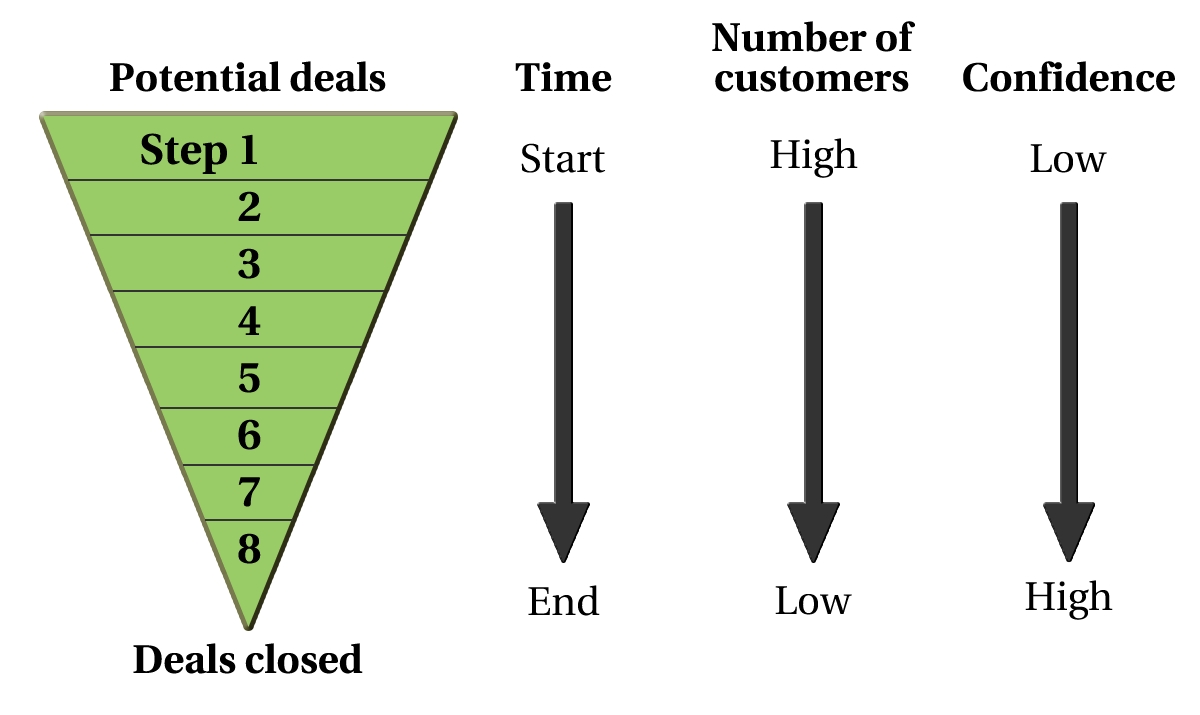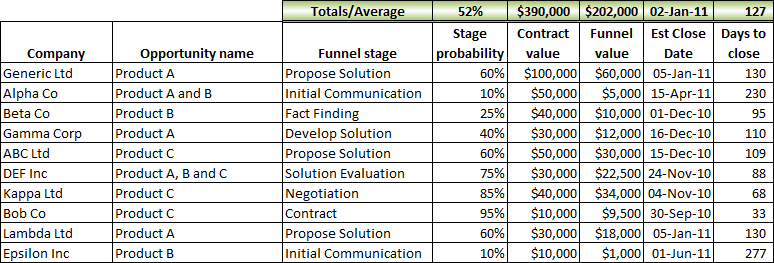Always be closing… That doesn’t mean you’re always closing the deal, but it does mean that you need to be always closing on the next step in the process.”
A sales strategy is not just about closing deals, it is about defining a sales process that accurately reflects an organization, its customers, and the products or solutions that it sells. By truly understanding its customers and by actually solving its customers’ problems, a company can define and execute a sales process that will increase the likelihood of reaching its ultimate objective: a closed deal and money in the bank.
This article describes the steps to create a business-to-business (B2B) sales process and shows how these steps are used to build a sales funnel. It also provides tips for effective and consistent execution of that process to get initial sales and improve upon them.
Note that the marketing and sales processes are different. Marketing is about generating qualified leads, sales is about taking those leads and converting them to dollars. It is good business practice to separate the two processes but information from each process will impact the other. Note that this article assumes some marketing and communications activity to get the lead in the first place. The sales process as defined in this article starts with an identified potential customer.
Understanding Customer Demands
The first step in building a sales process is to understand the demands of customers. A customer demand is comprised of two elements:
- The customer’s need or desire for a product or service
- The customer’s ability to pay for a product or service
Verifying both elements of customer demand accomplishes the first two steps in building a sales process. By talking to potential customers, a company can find out what they really need and whether they have the ability to pay. Their ability to pay depends on their budget, of course, but it is also affected by the timeframe within which they could sign off on a deal. It is not inappropriate to ask a potential customer if they have the budget, who would sign off on the deal, and in what timeframe a deal could be closed. These questions allow a company to prioritize potential customers and identify those most willing and likely to buy the company’s offering. It is worth knowing which customers have the need, but not the ability to pay, but the initial focus will be on those customers that have both elements of demand.
Developing a Solution
Once the customer’s demands are understood, the next two steps in the process are to develop a solution that will meet these demands and then propose it to the customer. In some cases, these steps may be reversed so that the proposal is made to the customer before the solution is developed. In other cases, it may be preferable to present a proposal based on an incomplete solution that will be refined based on feedback from the customers
Proposing the solution requires input from the potential customer. This step verifies that the proposed solution fits the customer’s requirements. Also, it reconfirms that they have the ability to pay for it. If they cannot reconfirm this, then it is better to move on to a customer that can. By focusing on a customer that has the ability to pay for the solution, the probability of a successful deal increases.
Evaluating the Solution with the Customer
The next step is to evaluate the solution with the customer. If the customer is enthusiastic and initiates contact without prompting, this is a good sign. If constant hounding is required to get a technical or business response to a solution, the sale is likely going nowhere.
Assuming the proposal meets the customer’s needs and the price point matches the customer’s value point, then this step in the sales process should be limited to a few small areas of refinement. The key is to act decisively on customer feedback. Changes should be implemented (or dismissed with explanation) as quickly as possible to close this step. One effective strategy to close the step is for the supplier company to agree to a set of product changes, but in return, the customer agrees to buy the solution “as is,” with or without a discount. This guarantees the sale early in the process, gets the customer using the solution as soon as possible, and provides the opportunity for further feedback and updates in the next version of the solution.
Typically, this is one of the steps where there is a high risk of the customer withdrawing their interest. The main reasons for losing the customer at this step in the process are:
- Misleading information was provided by one of the parties.
- The customer no longer sees the fit between the solution and their needs.
- The supplying company is not able to introduce the required changes to the solution in a timely or cost-effective manner.
Negotiation and Contracts
If the previous steps in the sales process have been completed successfully, there is typically not a lot left to negotiate. The key points to focus on in the negotiation process are:
- Outstanding product features to be implemented
- Release date
- Selling price, including volume discounts
- Warranties or maintenance costs
The goal of the negotiation step is to resolve all of the business issues, not the legal issues, which are covered in the contract step. Introducing legal departments too early will stall the negotiation and jeopardize the sales process. The negotiation team should include the signing authority, a finance representative, and a business line manager.
Once agreement has been reached, the negotiation step is formally closed by issuing a letter of intent outlining all of the business issues. This letter is then forwarded to the legal team and becomes the main content of a formal contract.
Note that sales can be lost even in the contract phase, for example if a legal department finds an issue relating to intellectual property. The contract step in the process does not necessarily represent a won sale and it might initiate a further round of negotiations or even a lost sale.
Deals Lost Along the Way
Failing to pass any step in the process means the sale is lost. If the customer does come back at some point in the future, then the sales process should start again from the beginning because the conditions of the sale are likely to have changed. Although losing a sale is undesirable, it is critical to learn from the loss. If the potential sale was in response to a request for proposal (RFP), an official debrief can be requested, especially if the RFP was issued by a government organization. In any case, it is important to follow up with the customer and find out why they did not purchase the solution. From this feedback, the supplier can determine what changes to the solution or process could be made so that the sale will be won if the opportunity presents itself again.
Closing a Deal
This step is a milestone rather than a specific task. When the contract is signed by both parties, this marks the end of the sales process and the beginning of a customer relationship management process. Hopefully, it is also the beginning of a long-term relationship. The supplier should work hard to keep the new customer, since it typically costs 10 times more to attract a new customer than to sell to an existing one.
Building a Sales Funnel
The sales process represents the natural evolution of a deal and it is straightforward to follow one deal through the process. In reality, many deals may be in progress at the same time and at different steps. A sales funnel is a way to track potential customers through the sales process. It helps assess the health and balance of projected sales by providing information on the following:
- the progress of each customer through the sales process
- the value of the opportunity associated with a customer
- how long customers are taking to move down the funnel
- how many customers are at each step
- projected revenue forecasts for cash flow statements
The funnel metaphor for a sales process is based on the gradual narrowing of potential deals into actual deals. Figure 1 shows a graphical representation of the properties of a sales funnel. As customers progress from one step in the sales process to another, some potential deals fall through, but the company’s confidence in the remaining deals increases.
Figure 1. Properties of a Sales Funnel
The first step in setting up a sales funnel is to assign a probability to each step in the sales process. Typically, this is the estimated probability of a customer at that stage in the process, ultimately reaching the final step in the process. In other words, it is the likelihood that a customer at a given stage will eventually buy the solution. Using the sales process steps outlined earlier, hypothetical probabilities can be assigned to each step of the sales process, as follows:
- Establish that the customer need or desire exists (5%)
- Establish that the customer has ability to pay for a solution (10%)
- Develop solution (30%)
- Propose solution (60%)
- Evaluate solution (65%)
- Negotiate deal (70%)
- Create contracts (90%)
- Close deal (100%)
Another approach would be to assign a probability of the customer moving to the next step in the process. The calculations are different in this case, but the overall effect is the same.
The next step is to take a potential customer, insert them in the process, and assign a contract value to the opportunity. In this way, a spreadsheet representation of the funnel is built. This spreadsheet is used to track the flow of customers through the sales process. Relevant information about individual deals or the entire sales process can then be extracted.
To illustrate this process, Figure 2 shows a hypothetical spreadsheet for a company’s sales funnel. Note that they are proposing a solution to Generic Ltd. This deal is currently at the proposal step in the sales process, which has a 60% probability of leading to a closed deal, at which point it would be worth $100,000. Each deal will either close or not, but the probabilities of closing can be used to calculate a weighted value for each potential deal. This provides a reasonable estimate of what actual value is likely to come from the group of deals as a whole. In the case of this particular deal, the weighted value is $60,000 ($100,000 x 60%). The analysis is extended by including an estimated closing date. In the case of Generic Ltd., the closing date is the 15th of January, 2011.
Figure 2. A Hypothetical Spreadsheet Representation of a Company’s Sales Funnel
The final step is to add the credit terms, which gives a projection of cash in the bank. Unfortunately, this exercise sometimes can become demoralizing because it is human nature to overestimate: i) the probability of getting a sale, ii) the sale amount, and iii) when the sale is going to close. However, when coupled with honest estimates, these calculations truly show when the “rubber hits the road.”
When all potential deals are recorded in the sales funnel, the weighted values can be projected over the next fiscal year or beyond. Over time, as the company’s experience with its customers grows, the probabilities will be refined and the funnel estimate of projected revenue will improve.
Conclusions
Developing a relevant and workable sales process is perhaps the most important aspect of a successful sales strategy. Organizations usually develop their sales strategy through trial and error, which involves a lot of wasted time and energy. A well-defined sales process, supported by a sales funnel, forces a company to be realistic about how well their sales tactics work and helps to focus on the areas that require improvement.

